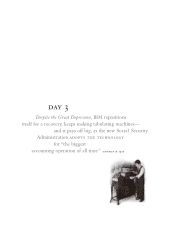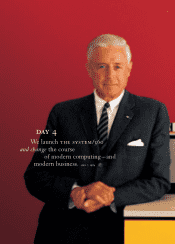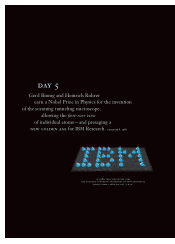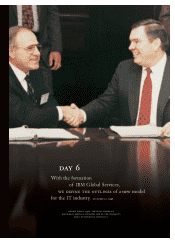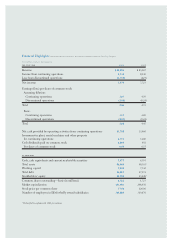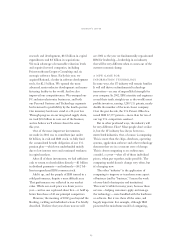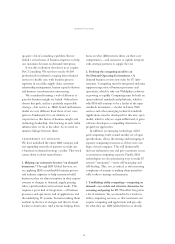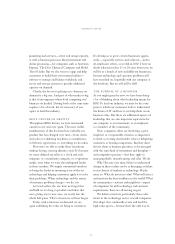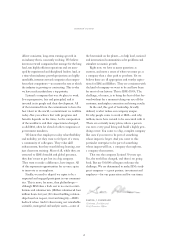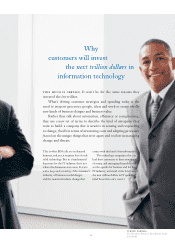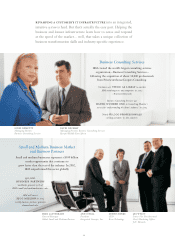IBM 2002 Annual Report Download - page 15
Download and view the complete annual report
Please find page 15 of the 2002 IBM annual report below. You can navigate through the pages in the report by either clicking on the pages listed below, or by using the keyword search tool below to find specific information within the annual report.13
research and development, $4.8 billion in capital
expenditures and $4 billion in acquisitions.
We took advantage of reasonable valuation levels
and acquired several companies, including
PricewaterhouseCoopers Consulting and six
strategic software firms. Early this year, we
acquired Rational, a leader in software development
tools, for $2.1 billion. We opened the most
advanced semiconductor development and manu-
facturing facility in the world. And we also
improved our competitiveness. We revamped our
PC and microelectronics businesses, and both
our Personal Systems and Technology segments
had returned to profitability by the fourth quarter.
Our inventory levels now stand at a 20-year low.
Through progress on our integrated supply chain,
we took $5.6 billion in costs out of the business,
and we believe we’ll achieve about the same
this year.
One of the most important investments
we made in 2002 was to contribute just under
$4 billion, in cash and IBM stock, to fully fund
the accumulated benefit obligation of our U.S.
pension plan—which was underfunded mainly
due to low interest rates and continued weakness
in capital markets.
After all of these investments, we had sufficient
cash to return to shareholders directly—$1 billion
in dividend payments—and indirectly—$4.2 bil-
lion in repurchased IBM common stock.
Add it up, and the people of IBM turned in a
solid performance, despite a most difficult year.
That performance was reflected in our market
value. While our stock price was down year to
year—and no one is pleased about that—it held up
better than those of all our principal competitors.
However, the meaning of 2002 goes beyond the
blocking, tackling and individual actions I’ve briefly
described. I believe that years from now we will
see 2002 as the year we fundamentally repositioned
IBM for leadership—leadership in an industry
that will be very different when it comes out of the
current economic slump.
a new game for
information technology
In some ways, the IT industry will remain familiar.
It will still thrive on fundamental technology
innovation—an area of unparalleled strength for
your company. In 2002,
IBM
scientists and engineers
scored their tenth straight year as the world’s most
prolific inventors, earning 3,288 U.S. patents, nearly
double the number of the next closest company.
Over the past decade, the U.S. Patent Office has
issued IBM 22,357 patents—more than for ten of
our top U.S. competitors combined.
But in other profound ways, the industry will
be very different. How? Most people don’t realize
it, but the IT industry has always been two,
interrelated industries. One, of course, is computing.
This is more than the chips, databases, operating
systems, application software and other technology
elements that are in a constant state of change.
This is about computing as an architecture,
a model, a system—what all of those individual
pieces, when put together, make possible. The
computing model doesn’t change very often, but
it’s changing now.
The other “industry” is the application of
computing to improve or transform some aspect
of business (and by “business,” I mean the work
of every kind of enterprise and institution).
This wasn’t visible for many years, because these
services—helping customers apply and manage
the technology—were bundled with the hardware
or software. But it was there all the same, and
hugely important. For example, although IBM
pioneered the mainframe model of computing,
chairman’s letter


